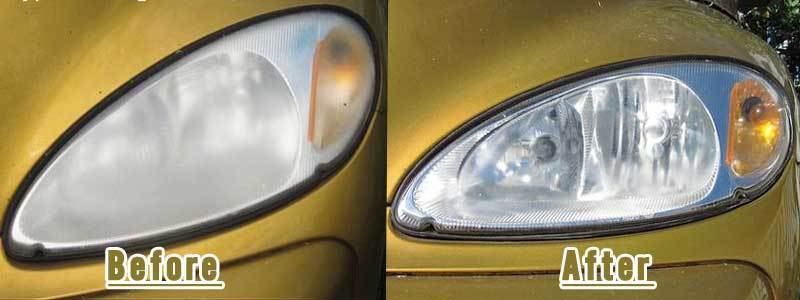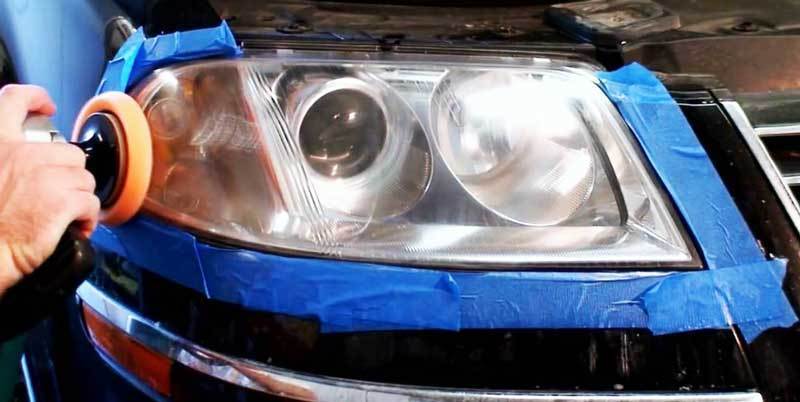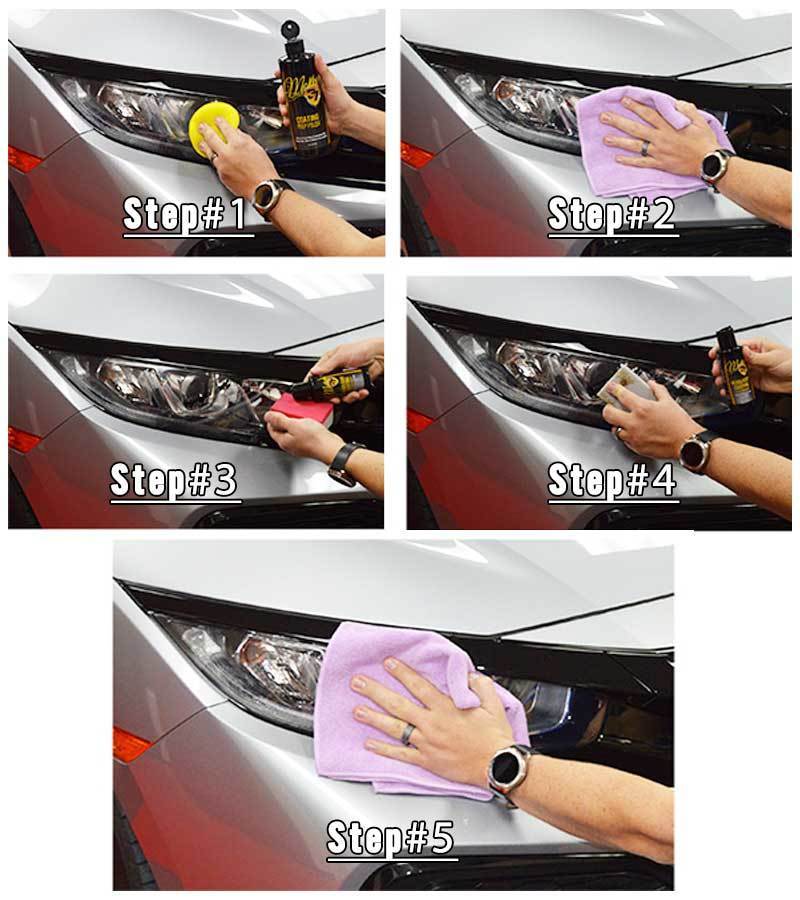Like any other earthly things, headlights also fade over time. Once beautiful, crazy clear headlights turn into dull, yellowish mirrors.
In fact, they become so distorted that you might have difficulty seeing what’s ahead, which can compromise your safety.
Many car owners opt for brand new headlights when headlights start to turn foggy, yellowish and hazy.

However, there is another method which will allow you to restore headlights to almost brand new condition. If you know how to restore car headlights with ceramic coatings, you’ll be able to refurbish them without breaking the bank.
In this article, we’re going to discuss why headlights deteriorate over time and the right method of applying ceramic coating while restoring them.
Common Headlight Deterioration Problems
Haziness And Yellowing
Headlights are usually made of polycarbonate plastic and like paint, they also decay over time. UV rays and sunlight play a part in breaking down your headlights hard coats. When that happens, hazy areas start to show themselves.
The process is called oxidization. This is the same reason LED headlights turn yellow. As the hard coat continue wearing off, the UV wavelengths get distorted and start giving a yellowish impression.

Cloudy And Dusty
If water gets trapped inside of your headlight cover, it vaporizes and the moisture creates a condensation. If can affect the clear light and make it dim and scattered. Over time, your headlight will start to look cloudy.
Same goes for dirt. You might not identify a thin layer of dirt in naked eyes, but it’s there. It can affect the brightness of your light, not to mention putting a decaying effect on your headlights protective coat.
How To Restore Car Headlights With Ceramic Coating?
Things You’ll Need
There are a few things you need before you start the restoration process. Unless you want to run towards nearby shop keeping your work half done, you need to collect these items in advance. They are-
- a. Painters tape to mask the headlight surroundings.
- b. Microfiber towel.
- c. Wet/dry sandpapers
- d. A bottle of the ceramic coating solution.
- e. Headlight polish
- f. A 2K clear coating solution.
- g. Buffing pads and rotary machine.
If you don’t want to grab them individually, there are several headlight restoration kits available on the market that can lessen your burden.
Step 1: Wash Your Headlight
The problem we see on our headlights, like fogginess, dim light might be the results of being unclean, not oxidized. So before you jump to your restoration job, give the headlights a thorough washing. Use soap and water for that. You should also clean the surrounding areas so that the tape can stick properly during the next step.
Step 2: Prepare The Headlight
The surrounding area around the headlights should be protected. There are two ways you can do this.
- a. Do the restoration separately by detaching the headlight enclosures.
- b. Masking adjacent areas by using tape.
You’ll be using sandpaper and chemical on the lenses during the restoration process. You wouldn’t want the surrounding areas to get scratched and damaged in the process. Although removing the headlights sound a little more work, it is the safest way.
If you choose to remove the headlights, I recommend you asking off the back of the lenses. This way they’ll be protected against water and accidental clear coating.
However, many people opt for restoring because they don’t want the hassle of removing the headlights altogether. If you can do the masking properly, there’s no problem using tapes to cover adjacent areas.
Use more tape and cover more surrounded areas than you think you might need to. To be surer, you can buy cheap plastic duck clothes to cover the areas.
You might ask why we’re being so cautious and the time spent is a waste. Trust me, it’s not. This will allow you to operate freely without any worry.

Step 3: Sand The Headlights
This is the most pivotal step of restoring car headlights. In this stage, we’re looking to clear off the damaged, yellowish layer from the lenses. Before approaching this stage, make sure you’ve worn a pair of hand gloves since you’ll come in touch of chemical and abrasive materials.
For this step, start with the lowest number of sandpaper you have. The lower number means they’re the more abrasive and do the heavy works.
Wet the headlights and sandpapers. Start rubbing the sandpapers gently, in straight, horizontal strokes. Make sure you sand in the same direction the whole time unless you want to put scratches on the lenses.
Make sure the sandpaper and headlights stay wet. This is especially important to avoid bad scratch marks. Be patient and don’t mind taking as much time as you need to complete the process. The quality of your restoration work depends on this step.
Repeat the process with higher number sandpapers. For example, if you’ve used 1000 grit sandpaper for the previous step, use 2000 and 3000 grit sandpapers for the next ones. Your movement should be straight like before, but the directions will be different.
If you sanded the lenses in a horizontal motion, the next direction should be diagonal across the lenses. As for the final sanding, use the sandpapers in the opposite diagonal motion.
With every sanding, you’ll see the yellowish vibe from the headlights getting off. The headlights will turn to milky white color from yellow. Make sure you rinse the lenses with warm, clean water after every sanding.
Also, make sure the sandpapers and lenses stay wet all the time. A water spray bottle or hose come handy in this situation.
Step 4: Apply Polish
Wipe and clean the headlight by a microfiber towel. After the sanding is complete, your headlights might still look slightly hazy. Don’t worry, we’re going to address this shortly.
Pour some of your polishing compounds on a microfiber towel. Apply the polish in a circular motion on the headlights for a few minutes. You’ll eventually see the headlights getting clearer as you go through this process.
You can cut the manual labor and use an orbital buffering machine instead. Use buffing pads instead of a towel in case you’re using the rotary machine. Polish the lens as long as you need, until it looks clear and defect-free.

Step 5: Apply Clear Coat
If you don’t want to apply polishes to the car headlights, it’s fine. You can opt for clear coating instead. Many car owners choose both to get the best results.
For this step, you need a two part clear coat solution. They’re also known as 2K clear coats. These solutions have an activator that lets the clear coat to cure and form a hardened layer. Cheaper 1K clear coats usually don’t have the option because they evaporate as they dry.
These solutions generally come in form of spray bottles. If not, you can either use a high pressure-low volume or a low pressure-low volume sprayer. Make sure your nose stay away from the solution as they can be harmful to your lungs. Use a disposable mask if needed.
Start applying the coat mildly. Overlap the quantity of the previous coat on each application. Make sure you start and finish the spraying from the surface, away from the lens to avoid spatter marks.
The final applications should be heavier coats. Make sure you level the clear coat in the final application. Give the solution time to cure, as recommended by the manufacturers. If you end up with an orange peel uneven surface accidentally, then sand the uneven areas lightly with ultra-fine 2000 grit sandpaper and a polish compound.
Step 6: Apply Ceramic Coating
Now, you’ve got yourself a pair of near factory quality headlights. But don’t start celebrating just yet. What good is a clear headlight if there’s nothing to protect it? Since you’ve just scraped all the old, yellow UV sealants, it’s time to apply a new coating. Otherwise, the headlights will turn hazy within a few days.
Obviously, the clear coating is good enough to go. It might sound silly to protect the clear coating since the main reason to use it is to protect the headlights. But if you want your headlights to stay protected for a long time, make sure to protect the clear coat.

You can use wax, sealants or ceramic coatings as the final protection. The former two lasts up to a few months, while the last one stays intact for a few years. We recommend using a ceramic coating if you want to stay worry-free for a long time.
Pour some ceramic coating solution on a microfiber cloth and apply it on the lenses. Make sure you don’t leave any spot. Wait for a few minutes and wipe the lenses with a dry microfiber towel. Allow some hours for the ceramic coating to cure.
After the process is complete, you’ll get yourself almost new looking car headlights. The process takes time, but after seeing the result, you’ll find the time well spent.
How To Protect Your Headlights From Re-oxidizing?
Well, after you apply the ceramic coating, you can expect a couple of years of protection. But, nothing is permanent in this world, and taking the headlight coatings for granted might allow them to wear soon. We’re not telling you to worry all the time, just some simple cautions will suffice.
1. Parking Place: Usually, a car spends more time sitting than running. Choosing the place where you keep the car parked is a critical decision. Always opt for cool, dry places out of direct sunlight for your car to park. Less UV exposure means less deterioration.
Also make sure the parking space is dry, not damp. Because a damp surrounding can cause the headlights to get foggy.
2. Cover Your Headlight: It’s really hard to keep your car under a roof all the time. If you must expose the car under the glazing sun, make sure to use protective layers.
Although ceramic coatings are enough, some car owners opt for thin plastic films to cover the headlights.
3. Use The Right Cleaning Products: Obviously, your headlights will need cleaning from time to time. Even though they look clean, a layer of road grimes might already sit upon them.
Refrain from using harmful chemicals and aggressive cleaners while cleaning the headlights. Make sure the cleaners you use are not overly acidic or detrimental.

Final Words
There are many professionals that offer headlight restoration services. However, that might something around a few hundred dollars. With some knowledge on how to restore headlights with ceramic coatings, you can do the job much cheaper, and in your own conditions.
However, make sure you go slow and take time if you find yourself in a pickle. Over time, the whole process will get easier. The steps are really easy, but they aren’t quick. It’ll take time, but after finishing, you’ll admit to yourself it was worth the time.
Hopefully, this article will help you along the process. Let us know how the method works out for you.
In today’s fast-paced world, many individuals face challenges when it comes to getting a good night’s rest. Whether it’s due to stress, lifestyle choices, or underlying health conditions, Sleep Problems have become a common concern. Addressing these issues is crucial, not only for one’s mood and productivity but also for overall health and well-being, as continuous sleep disruptions can lead to severe long-term complications. Sleep problems
While most of us cherish the idea of falling into a deep, restorative slumber after a long day, the reality is that a significant portion of the population grapples with Sleep Problems. These issues, ranging from insomnia to sleep apnea, can have profound effects on one’s daily life, affecting concentration, energy levels, and even emotional stability.

